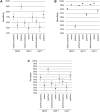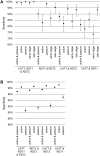Prospective evaluation of a rapid diagnostic test for Trypanosoma brucei gambiense infection developed using recombinant antigens
- PMID: 29590116
- PMCID: PMC5898764
- DOI: 10.1371/journal.pntd.0006386
Prospective evaluation of a rapid diagnostic test for Trypanosoma brucei gambiense infection developed using recombinant antigens
Abstract
Background: Diagnosis and treatment are central elements of strategies to control Trypanosoma brucei gambiense human African trypanosomiasis (HAT). Serological screening is a key entry point in diagnostic algorithms. The Card Agglutination Test for Trypanosomiasis (CATT) has been the most widely used screening test for decades, despite a number of practical limitations that were partially addressed by the introduction of rapid diagnostic tests (RDTs). However, current RDTs are manufactured using native antigens, which are challenging to produce.
Methodology/principal findings: The objective of this study was to evaluate the accuracy of a new RDT developed using recombinant antigens (SD BIOLINE HAT 2.0), in comparison with an RDT produced using native antigens (SD BIOLINE HAT) and CATT. A total of 57,632 individuals were screened in the Democratic Republic of the Congo, either passively at 10 health centres, or actively by 5 mobile teams, and 260 HAT cases were confirmed by parasitology. The highest sensitivity was achieved with the SD BIOLINE HAT 2.0 (71.2%), followed by CATT (62.5%) and the SD BIOLINE HAT (59.0%). The most specific test was CATT (99.2%), while the specificity of the SD BIOLINE HAT and SD BIOLINE HAT 2.0 were 98.9% and 98.1%, respectively. Sensitivity of the tests was lower than previously reported, as they identified cases from partially overlapping sub-populations. All three tests were significantly more sensitive in passive than in active screening. Combining two or three tests resulted in a markedly increased sensitivity: When the SD BIOLINE HAT was combined with the SD BIOLINE HAT 2.0, sensitivity reached 98.4% in passive and 83.0% in active screening.
Conclusions/significance: The recombinant antigen-based RDT was more sensitive than, and as specific as, the SD BIOLINE HAT. It was as sensitive as, but slightly less specific than CATT. While the practicality and cost-effectiveness of algorithms including several screening tests would need to be investigated, using two or more tests appears to enhance sensitivity of diagnostic algorithms, although some decrease in specificity is observed as well.
Conflict of interest statement
The authors have declared that no competing interests exist.
Figures





Similar articles
-
Sensitivity and Specificity of a Prototype Rapid Diagnostic Test for the Detection of Trypanosoma brucei gambiense Infection: A Multi-centric Prospective Study.PLoS Negl Trop Dis. 2016 Apr 8;10(4):e0004608. doi: 10.1371/journal.pntd.0004608. eCollection 2016 Apr. PLoS Negl Trop Dis. 2016. PMID: 27058033 Free PMC article.
-
Retrospective clinical performance evaluation of the Abbott Bioline HAT 2.0, a rapid diagnostic test for human African trypanosomiasis based on recombinant antigens.Trop Med Int Health. 2025 Feb;30(2):135-142. doi: 10.1111/tmi.14077. Epub 2024 Dec 23. Trop Med Int Health. 2025. PMID: 39716774 Free PMC article.
-
Performance of the SD BIOLINE® HAT rapid test in various diagnostic algorithms for gambiense human African trypanosomiasis in the Democratic Republic of the Congo.PLoS One. 2017 Jul 3;12(7):e0180555. doi: 10.1371/journal.pone.0180555. eCollection 2017. PLoS One. 2017. PMID: 28672036 Free PMC article.
-
[Diagnosis of human African trypanosomiasis in 2001].Med Trop (Mars). 2001;61(4-5):340-6. Med Trop (Mars). 2001. PMID: 11803824 Review. French.
-
Options for field diagnosis of human african trypanosomiasis.Clin Microbiol Rev. 2005 Jan;18(1):133-46. doi: 10.1128/CMR.18.1.133-146.2005. Clin Microbiol Rev. 2005. PMID: 15653823 Free PMC article. Review.
Cited by
-
Recent progress in diagnosis and treatment of Human African Trypanosomiasis has made the elimination of this disease a realistic target by 2030.Front Med (Lausanne). 2022 Nov 3;9:1037094. doi: 10.3389/fmed.2022.1037094. eCollection 2022. Front Med (Lausanne). 2022. PMID: 36405602 Free PMC article. Review.
-
Development and implementation of a strategy for intensified screening for gambiense human African trypanosomiasis in Kongo Central province, DRC.PLoS Negl Trop Dis. 2020 Oct 15;14(10):e0008779. doi: 10.1371/journal.pntd.0008779. eCollection 2020 Oct. PLoS Negl Trop Dis. 2020. PMID: 33057341 Free PMC article.
-
Performance of clinical signs and symptoms, rapid and reference laboratory diagnostic tests for diagnosis of human African trypanosomiasis by passive screening in Guinea: a prospective diagnostic accuracy study.Infect Dis Poverty. 2023 Mar 20;12(1):22. doi: 10.1186/s40249-023-01076-1. Infect Dis Poverty. 2023. PMID: 36941656 Free PMC article. Clinical Trial.
-
Raman spectroscopic analysis of skin as a diagnostic tool for Human African Trypanosomiasis.PLoS Pathog. 2021 Nov 15;17(11):e1010060. doi: 10.1371/journal.ppat.1010060. eCollection 2021 Nov. PLoS Pathog. 2021. PMID: 34780575 Free PMC article.
-
Feasibility of a dried blood spot strategy for serological screening and surveillance to monitor elimination of Human African Trypanosomiasis in the Democratic Republic of the Congo.PLoS Negl Trop Dis. 2021 Jun 11;15(6):e0009407. doi: 10.1371/journal.pntd.0009407. eCollection 2021 Jun. PLoS Negl Trop Dis. 2021. PMID: 34115754 Free PMC article.
References
-
- Simarro PP, Cecchi G, Franco JR, Paone M, Diarra A, et al. (2012) Estimating and mapping the population at risk of sleeping sickness. PLoS Negl Trop Dis 6: e1859 doi: 10.1371/journal.pntd.0001859 - DOI - PMC - PubMed
-
- WHO (2016) Global Health Observatory data repository, Human African Trypanosomiasis. Geneva, Switerzland: World Health Organization.
-
- Franco JR, Simarro PP, Diarra A, Ruiz-Postigo JA, Jannin JG (2014) The journey towards elimination of gambiense human African trypanosomiasis: not far, nor easy. Parasitology 141: 748–760. doi: 10.1017/S0031182013002102 - DOI - PubMed
-
- Jamonneau V, Ilboudo H, Kabore J, Kaba D, Koffi M, et al. (2012) Untreated Human Infections by Trypanosoma brucei gambiense Are Not 100% Fatal. PLoS Negl Trop Dis 6: e1691 doi: 10.1371/journal.pntd.0001691 - DOI - PMC - PubMed
-
- Magnus E, Van Meirvenne N, Vervoort T, Le Ray D, Wery M (1978) Use of freeze-dried trypanosomes in the indirect fluorescent antibody test for the serodiagnosis of sleeping sickness. Ann Soc Belg Med Trop 58: 103–109. - PubMed
Publication types
MeSH terms
Substances
LinkOut - more resources
Full Text Sources
Other Literature Sources

